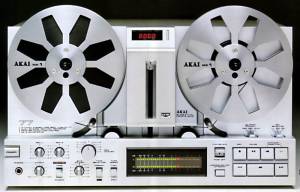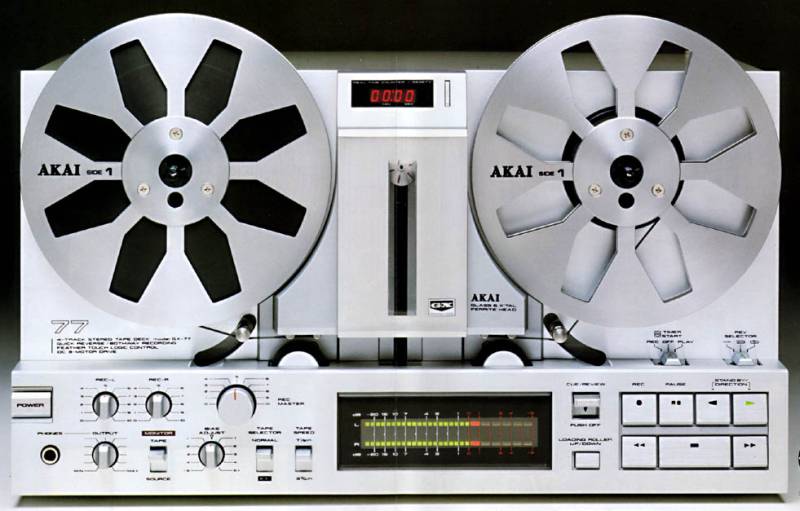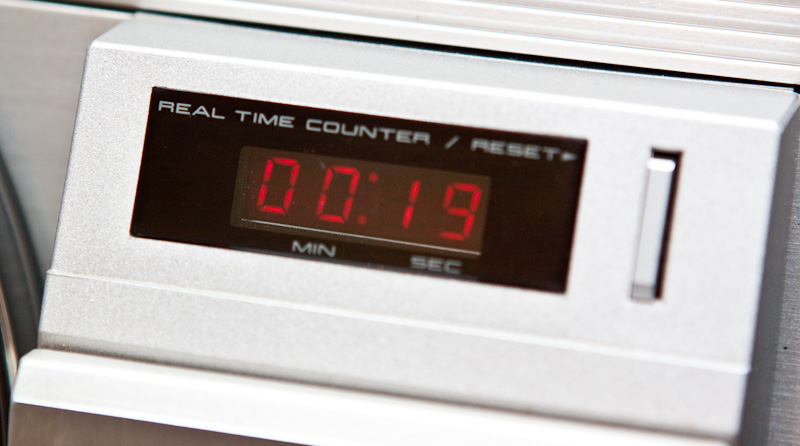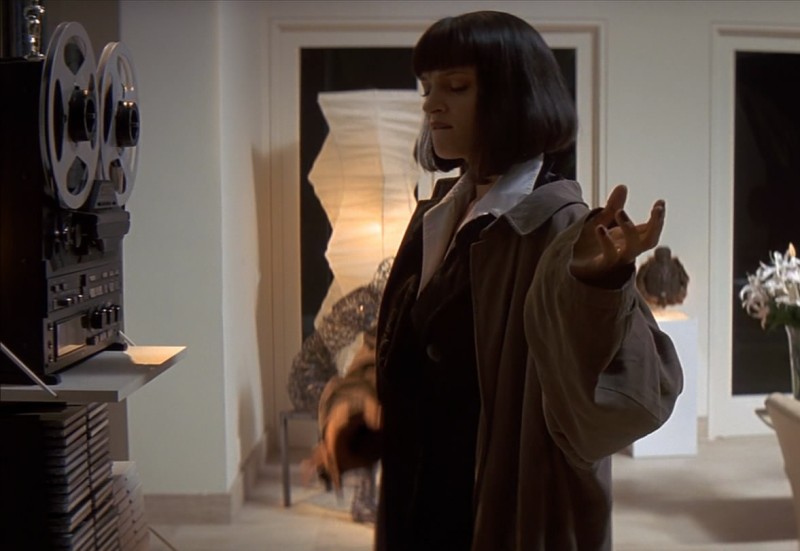The legendary seventy-seventh Akai
 Fans of the group “Nautilus Pompilius” know the song “Just to be” well from the album “Separation” of 1986. It is very good in itself, and I know this piece of text by heart:
Fans of the group “Nautilus Pompilius” know the song “Just to be” well from the album “Separation” of 1986. It is very good in itself, and I know this piece of text by heart:I have at home Riesling
And tokay
New records
Seventy seventh akay
And only recently I wondered: what is this, in fact, for the 77th Akai? It turned out that the mention in the song is not the only advantage of the Akai GX-77 tape recorder. This model, though not the most technically perfect (more abruptly), is incredibly good in appearance and certainly an order of magnitude better than the Soviet counterparts. Of course, I could not miss the chance to get acquainted with a live specimen of this tape recorder, and at the same time recall what another historical sound carrier was like that successfully existed in parallel with vinyl and compact cassettes. In English it is called “reel-to-reel”, in our opinion, “coils”, “reels” or officially “magnetic tape”.
')

Perhaps, in 2010, 15 years after both vinyl and reels, and compact cassettes somehow ceased to be relevant, it is worth explaining how the reel-to-reel tape recorder differed from two other popular carriers of the twentieth century. Unlike vinyl, the tape recorder could be used both for recording your own music and for rewriting company records with foreign music. My parents, for example, did not have a single company record, but on the coils there was all the actual music of the late 70s, carefully copied from vinyl. Unlike compact cassettes, the “reel” provided noticeably better recording quality. It affected both the speed of the tape - 9.5 or 19 centimeters per second (it was 38 cm / s, but not for home use), versus 4.76 centimeters per second on the compact tape, and the fact that the ribbon was wider.

Released in 1981, the Akai GX-77 had the following specifications:
Reproduction from reels with a diameter up to 7 inches (length of a tape is 525 meters)
Two sets of three heads each: for erasing, recording and playback
3 motors: 1 for rollers, two for rotating coils
Frequency range: 25-33000 Hz at a speed of 19 cm / s, 25-26000 Hz at a speed of 9.5 cm / s
Signal to noise ratio:> 63 dB at 19 cm / s
Line in and out, microphone in, optional wired remote control

Among the features of the tape recorder is worth noting the system of manual and automatic reverse, as well as the unusual arrangement of the heads, at an angle to each other. The tape is fed to the heads with the help of a special roller, and this system is called the “lambda loading system”. This feature is unique to the GX-77; in other models, the classic head layout was used. The tape recorder weighs 17 kilograms, but in reality it turned out to be quite compact. It depends on what to compare, of course, and I could only compare with domestic models. For example, a well-known tape recorder Rostov-102 weighs 25 kilograms.

I was interested to know how much such a “gadget” cost in 1981. In the Japanese market Akai GX-77 silver cost 128 thousand yen, the black model was more expensive - 132 thousand. At the rate of January 1981 (29 years ago!) It is 632 US dollars with kopecks, taking into account inflation - one and a half thousand. Since a resident of the USSR could not simply exchange dollars for rubles at the official rate, the cost and, most importantly, the value of such equipment in our country was calculated quite differently. Considering that the price even for the mentioned “Rostov” was 850 rubles, it was possible to buy the “seventy-seventh akay” for no less than a thousand, and at the same time it was necessary to “get it”. Sometimes getting it was even more difficult, although it was almost impossible to accumulate such a huge amount when 200 rubles is a good salary.

Despite the venerable age, a copy of the "seventy-seven", with whom I met, looks very cheerful. Coils can be closed with a special lid that folds up. All sorts of switches and regulators invariably cause me mad delight, but here it is all done with considerable taste. In a word - imported goods!

The main control buttons. The tape recorder almost instantly switches the "sides" of the tape, and can do it automatically. In general, it is extremely easy to manage, if we compare it, again, with the not so perfect Soviet tape recorders of those times. There are no levers that need to be switched with pressing, effort and gnash, there is not even a trace.

The electronic tape counter does not show “parrots”, but the usual playback time. You can reset it at any time using the button on the right.

Line level or recording level indicator. To be honest, I like dial gauges more, but this is a matter of taste.
I recorded a small video with a demonstration of the main modes of the tape recorder: playback, reverse and rewind. Nothing special, just a reason for nostalgia :) The view of the spinning coils is still fascinating. In modern audio devices, even in high-quality CD players, there is no such sensation of the process as in the case of bobbin. Another video on this link in detail shows the process of supplying the tape to the heads. Both videos are best viewed in HD.
Well, since the release of the Akai GX-77, many years have passed, and, unfortunately, the Bobinniki are outdated more than vinyl. Magnetic tape - less durable media. I still enjoy listening to records that are over 50 years old. But the collection of music on the coils inherited from the parents is practically unsuitable for use: the Soviet tape is instantly showered, and after every five minutes of listening you have to clean the heads. A foreign-made magnetic tape is more durable, and the tape recorder can now be used both to listen to old recordings and to re-record music from vinyl: if you have a collection record worth a thousand dollars, you probably don’t want to cut it to holes. The tape recorder is now either a specialized studio device, or a working tool for a music lover.
But tape recorders can often be found in films, TV shows and even cartoons (well, in the songs, of course, in one absolutely for sure). In modern culture, the “bobinnik” most often appears in the frame along with the staff of the special services, hinting that they use well, very serious equipment .

In Francis Ford Coppola's masterpiece Apocalypse Today, the Bobbinnik appears in one of the most famous scenes. It is from him play "Flight of the Valkyries" by Richard Wagner. In 1969, during the Vietnam War, compact cassettes already existed, but the reel-to-reel tape recorder, of course, looks more impressive.

Apparently, for the same reasons, Quentin Tarantino used a tape recorder in Pulp Fiction. If Mia, Marcellus Wallace's wife, had included music from a CD player, it would have looked very different.
I want to thank Konstantin Diloyan for the opportunity to see the vintage Akai GX-77 in action. By the way, the tape recorder is put up for sale on the hammer. The Akai GX-77 advertising posters shown here can be viewed in high resolution on this page.
Source: https://habr.com/ru/post/81449/
All Articles